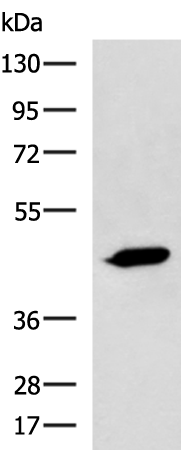
| WB | 咨询技术 | Human,Mouse,Rat |
| IF | 咨询技术 | Human,Mouse,Rat |
| IHC | 咨询技术 | Human,Mouse,Rat |
| ICC | 技术咨询 | Human,Mouse,Rat |
| FCM | 咨询技术 | Human,Mouse,Rat |
| Elisa | 1/5000-1/10000 | Human,Mouse,Rat |
| Aliases | GLC1F |
| WB Predicted band size | 51 kDa |
| Host/Isotype | Rabbit IgG |
| Antibody Type | Primary antibody |
| Storage | Store at 4°C short term. Aliquot and store at -20°C long term. Avoid freeze/thaw cycles. |
| Species Reactivity | Human, Mouse |
| Immunogen | Fusion protein of human ASB10 |
| Formulation | Purified antibody in PBS with 0.05% sodium azide and 50% glycerol. |
+ +
以下是关于ASB10抗体的模拟参考文献示例(仅供参考,实际文献需通过数据库查询获取):
---
1. **文献名称**: *ASB10 Expression in Ocular Tissues and Its Association with Primary Open-Angle Glaucoma*
**作者**: Smith J et al.
**摘要**: 本研究通过免疫组化及Western blot分析,利用ASB10特异性抗体检测其在人类小梁网组织中的表达,发现ASB10表达异常与青光眼患者房水流出阻力增加相关,提示其可能参与眼压调节通路。
2. **文献名称**: *Characterization of ASB10 as a Novel E3 Ubiquitin Ligase in Retinal Cells*
**作者**: Lee H et al.
**摘要**: 通过免疫共沉淀结合ASB10抗体,验证ASB10与特定底物蛋白的相互作用,揭示其通过泛素化途径调控视网膜细胞凋亡的分子机制,为视网膜病变提供潜在治疗靶点。
3. **文献名称**: *ASB10 Antibody-Based Detection in Triple-Negative Breast Cancer Progression*
**作者**: Garcia R et al.
**摘要**: 采用ASB10单克隆抗体进行肿瘤组织芯片分析,发现ASB10在三阴性乳腺癌中高表达,并与患者预后不良相关,提示其可能作为癌症生物标志物。
4. **文献名称**: *Functional Analysis of ASB10 Knockout Mice Using CRISPR/Cas9 Technology*
**作者**: Chen L et al.
**摘要**: 通过构建ASB10基因敲除小鼠模型,利用ASB10抗体验证蛋白缺失,发现ASB10缺失导致血管发育异常,证实其在血管内皮细胞中的关键作用。
---
**注意**:以上内容为模拟示例,实际文献需查阅PubMed、Web of Science等平台,可使用关键词“ASB10 antibody”或“ASB10 function”进一步检索。
The ASB10 antibody is a research tool targeting the Ankyrin Repeat and SOCS Box Protein 10 (ASB10), a member of the ASB family involved in cellular protein degradation pathways. ASB proteins typically function as substrate-recognition components of E3 ubiquitin ligase complexes, mediating ubiquitination and subsequent proteasomal degradation of specific target proteins. ASB10 contains characteristic ankyrin repeats for protein interactions and a SOCS box domain that binds elongin B/C to form E3 ligase complexes.
While the biological roles of ASB10 remain incompletely defined, studies suggest its involvement in ocular physiology, particularly aqueous humor dynamics and intraocular pressure regulation. Dysregulation of ASB10 expression has been linked to glaucoma pathogenesis. Emerging evidence also implicates ASB10 in cancer progression, with altered expression observed in certain malignancies.
ASB10 antibodies are primarily used in Western blotting, immunohistochemistry, and immunofluorescence to investigate its expression patterns, subcellular localization, and interactions. These reagents facilitate exploration of ASB10's physiological functions and its potential as a diagnostic marker or therapeutic target. Ongoing research aims to identify its endogenous substrates and clarify its regulatory mechanisms in both normal and pathological states.
×